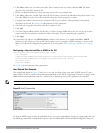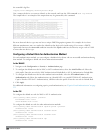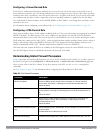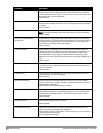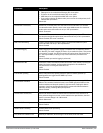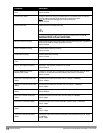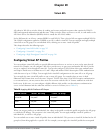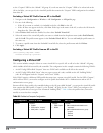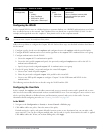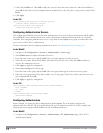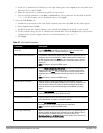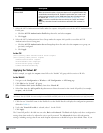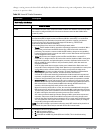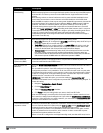
DellPowerConnectW-SeriesArubaOS6.2 | User Guide VirtualAPs | 315
Chapter 20
Virtual APs
APs advertise WLANs to wireless clients by sending out beacons and probe responses that contain the WLAN’s
SSID and supported authentication and data rates. When a wireless client associates to an AP, it sends traffic to the
AP’s Basic Service Set Identifier (BSSID) which is usually the AP’s MAC address.
In the Dell network, an AP uses a unique BSSID for each WLAN. Thus a physical AP can support multiple WLANs.
The WLAN configuration applied to a BSSID on an AP is called a
virtual AP.
You can configure and apply multiple
virtual APs to an AP group or to an individual AP by defining one or more virtual AP profiles.
This chapter describes the following topics:
l "Configuring Virtual AP Profiles" on page 315
l "Configuring a Virtual AP " on page 316
l "Configuring a High-Throughput Virtual AP" on page 340
Configuring Virtual AP Profiles
You can configure virtual AP profiles to provide different network access or services to users on the same physical
network. For example, you can configure a WLAN to provide access to guest users and another WLAN to provide
access to employee users through the same APs. You can also configure a WLAN that offers open authentication
and Captive Portal access with data rates of 1 and 2 Mbps and another WLAN that requires WPA authentication
with data rates of up to 11 Mbps. You can apply both virtual AP configurations to the same AP or an AP group .
You can apply the same virtual AP profiles to one or more AP groups. For example, there are users in both
Edmonton and Toronto that access the same “Corpnet” WLAN. Note that if your WLAN requires authentication
to an external server, you may want to have users who associate with the APs in Toronto authenticate with their
local servers. In this case, you can configure a slightly different AAA profiles; one that references authentication
servers in the Edmonton and the other that references servers in Toronto (see to Table 85).
WLAN Profiles “default” AP Group “Toronto” AP Group
Virtual AP “Corpnet-E” “Corpnet-T”
SSID “Corpnet” “Corpnet”
AAA “E-Servers” “T-Servers”
Table 85:
Applying WLAN Profiles to AP Groups
When you assign a profile to an individual AP, the values in the profile override the profile assigned to the AP group
to which the AP belongs. The exception is the virtual AP profile. You can apply multiple virtual AP profiles to
individual APs, as well as to AP groups.
You can exclude one or more virtual AP profiles from an individual AP. This prevents a virtual AP, defined at the AP
group level, from being applied to a specific AP. For example, you can apply the virtual AP profile that corresponds




